Australia’s Classic Rarities. Rare coins that have timeless appeal.
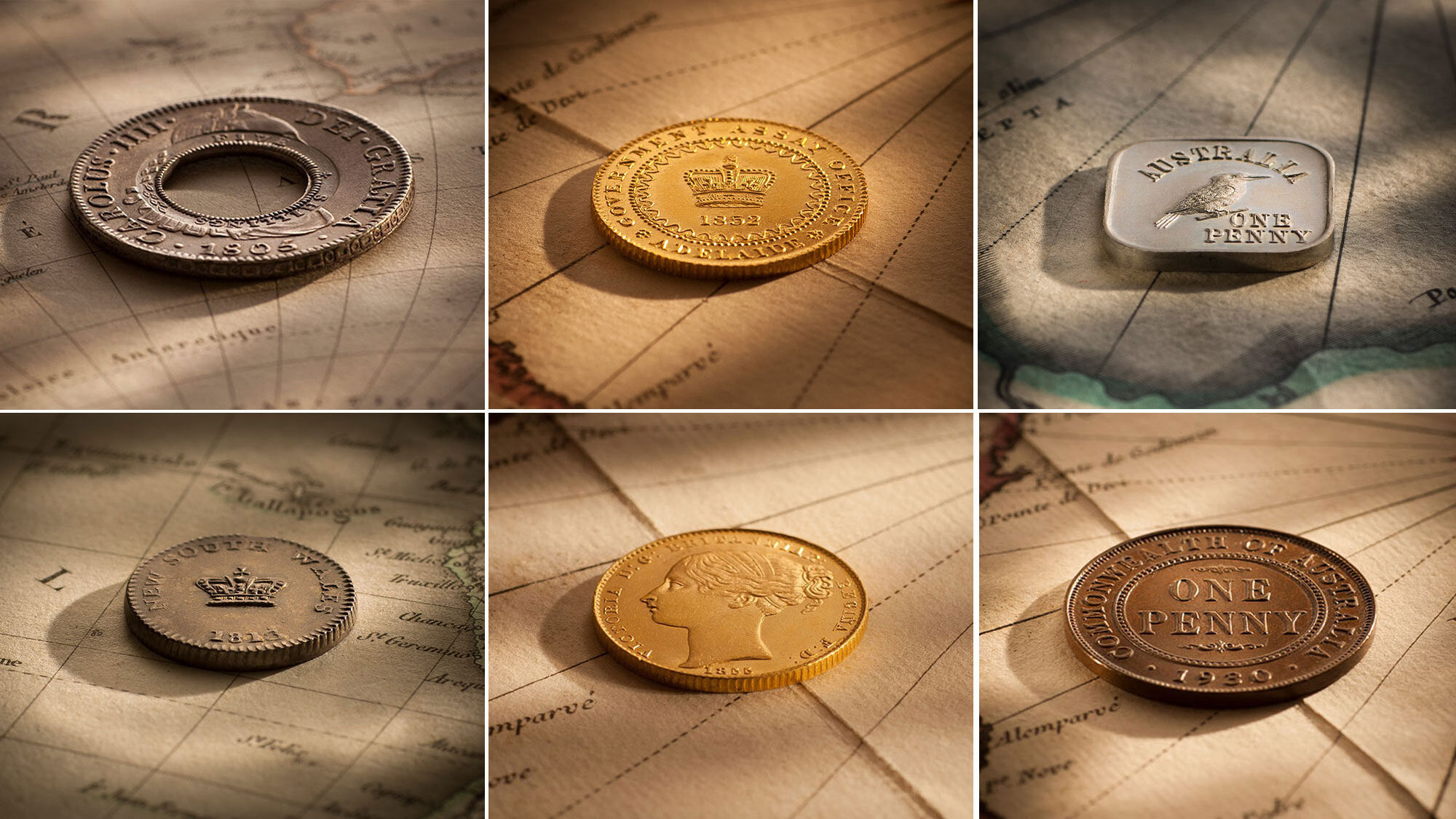
Rare coins that have timeless appeal. In this, we are talking about the nation’s first silver coins, the 1813 Holey Dollar and 1813 Dump, the inspiration of Governor Lachlan Macquarie.
And the nation’s first gold coins spawned by the Gold Rush of 1851, the 1852 Adelaide Pound Type I and Type II. And the 1855 Sydney Mint Sovereign and Half Sovereign.
We are also talking about the nation’s first cupro-nickel square coin. A penny that featured Australia’s native bird, the 1919 Kookaburra Square Penny.
And last, and by no means least, the coin struck during the Depression, that brought instant wealth to its owners, the 1930 Penny.
These coins present a timeline of key points in Australia’s history.
They are highlights of our financial history and for collectors, highlights of our numismatic history. They also define Australians as people, our psyche, our entrepreneurial spirit and our resilience as a nation.
They set the framework for today's coin collectors.
Start your collecting journey …
If you are setting out on your journey to acquire Australia’s classic coin rarities, let our charts be your guide and your starting point.
Our first chart details the eight coins referred to above and their original mintage. With regards to the 1919 Square Penny and the 1930 Penny the mintage figures are only estimates as there is no official record of the numbers struck. (Denoted by an * in the chart.)
For collectors the key to evaluating the rarity of a coin (and hence its value) is to look beyond the mintage and consider its availability.
The availability is an indication of the number of examples available to collectors in a lifetime of collecting.
For example, it is noted that the original mintage of the Holey Dollar is 39,910. The coins were demonetised in 1829 with the vast majority recalled and melted down.
Today there are approximately 200 Holey Dollars held by private collectors with perhaps 100 held in museums. The figure '200' is the critical one for collectors. The original mintage is to a certain extent irrelevant.
The availability of 200 Holey Dollars, of varying qualities and varying prices, means that if a collector passes on an example in one particular year, he/she is quite likely to see another within two years … the downside being that prices will most likely have risen in the intervening time.
When you consider the number of collectors (worldwide) that are potential buyers of Australia's classic coins, you have a better understanding of just how extraordinarily scarce they are.
The second chart details the number of top tier examples, with the quality range that defines ‘top tier’ indicated in brackets.
It is an interesting exercise in relativity, if nothing else.
The extreme rarity of the 'top tier' classics helps us understand why such pieces are so sought after. And why they are so highly valued and command the prices that they do.
Throughout this article, be advised that Coinworks uses Australian grading standards. This should not be confused with P.C.G.S. and N.G.C. grading levels.
Chart 1. The original mintage. And the availability in today's collector market of the Holey Dollar, Dump, Adelaide Pound Type I and II, 1855 Sovereign and 1855 Half Sovereign, 1919 Square Penny and 1930 Penny.
Chart 2. Our estimates of the number of 'top tier' coins, with the quality range defined by that term indicated in brackets. The figures are based on auction data and Coinworks private sales.
The 1813 Holey Dollar and Dump
The Holey Dollar and Dump are the nation’s first coins struck in 1813 under the direction of Governor Lachlan Macquarie.
The British Government had no capacity to supply Macquarie with metal blanks to create Australia’s first coinage so, he improvised and ordered 40,000 Spanish Silver Dollars - foreign coinage - to use as his substitute for blanks.
Macquarie enlisted the services of William Henshall, a convicted forger, to cut a hole in each dollar thereby creating two silver pieces out of one. The donut shaped silver piece was over stamped around the edge of the hole with the date 1813 and New South Wales and became the Holey Dollar with a monetary value of five shillings. The small disc that fell out of the centre of the silver dollar was over stamped with the date 1813, New South Wales and a Crown and became the Dump. Its monetary value was fifteen pence.
The shipment of 40,000 Spanish Silver Dollars was converted into 39,910 Holey Dollars and 39,910 Dumps. Spoilage, mishaps during the minting process, and specimens sent to Great Britain as an official record of the striking account for the missing coins.
It is open to debate as to whether the Holey Dollars and Dumps solved the penal colony’s currency crisis. There is no debate however that the issuing of Australia’s first coinage symbolised the changing dynamics of the penal colony.
New South Wales had started out in 1788 as a jail, a repository for miscreants, under the governorship of Captain Arthur Phillip. It had emerged some twenty-five years later as a thriving economy requiring a formal medium of exchange to support a burgeoning commercial hub.


Photos shown above. The finest known 1813 Holey Dollar and the finest known 1813 Dump, both in Uncirculated quality.
Useful information if you are buying a Holey Dollar
The first step in the task of acquiring a Holey Dollar is to set your budget.
Holey Dollars are available in price ranges to suit all budgets, starting at $50,000 for a heavily circulated example up to the very best examples at $400,000-plus.
Quality is the prime force in determining the value of a Holey Dollar, but it is not the only force in setting a value. And herein lies the intrigue of the coin.
Lachlan Macquarie imported 40,000 Spanish Silver dollars to create Australia’s first coins. The order was not date specific, so any date would do. Any monarch would suffice, Charles III, Charles IV, Ferdinand VI or Ferdinand VII.
Nor did Macquarie purchase the coins direct from a particular mint. The shipment came from Madras, ordered from the East India Company, and was comprised of coins struck in the Spanish colonies of Mexico, Peru and Bolivia with some even sourced from the motherland, Spain.
And they all came at different quality levels, with the majority well worn.
The rarity of the monarch and the rarity of the mint together with its quality are the three attributes that determine the ultimate value of a Holey Dollar.
The Holey Dollar is one of Australia's most desirable coins. Talk to those fortunate enough to own one, either private collectors or institutions such as Macquarie Bank, National Museum of Australia and the Mitchell Library, and they will tell you that the Holey Dollar is viewed as the jewel in their collection.
Of the 200 Holey Dollars that are available to collectors, the chart below indicates the percentage of Holey Dollars found at each quality level.
It is noted that most Holey Dollars are today found well-worn with many looking like a tap washer.
The reason is simply that no quality parameters were set on Macquarie’s shipment of 40,000 silver dollars. That and the extensive use of the dollar as an international trading coin meant that most of the coins imported by Macquarie were well worn.

Useful information if you are buying a Dump
When William Henshall holed the Spanish Silver Dollar, he created two pieces out of one, a donut shaped piece which became the Holey Dollar and a tiny central disc which became the Dump. Both pieces, the Dump and the Holey Dollar, have historical standing as the nation’s first coins.
The Dump circulated widely in the colony, the extreme wear on most Dumps evidence that they saw considerable use. So, while the Dump may seem the diminutive partner of the Holey Dollar, the reality is top quality Dumps have authority.
Dumps are available in price ranges to suit all budgets, starting at $5000 for a well circulated example up to the very best examples at $100,000-plus.
The Dump is bought on its own merits as a collector’s item, simply because it is Australia's first coin.
It can also be acquired as a stand-alone investment piece for high quality Dumps are particularly scarce. In fact, far scarcer than a Holey Dollar in a comparable quality level and we refer you to the second chart shown above that details the availability of 'top tier' coins.
Or an 1813 Dump may be bought to partner its five shillings counterpart, the 1813 Holey Dollar. If the coin is going to be held in partnership with a Holey Dollar, then our suggestion would always be to observe the aesthetics and within reason marry the quality levels.
While the Holey Dollar offers options for collectors of the mint, monarch and the date, the Dump also offers options. Four dies were used in the striking of the 1813 Dump and they are referenced as the A/1, D/2, C/4 and E/3 with each die producing a vastly different style of coin.
The most aesthetically pleasing Dump is that struck using the A/1 die, which produced a coin that was well centred. Of the 800 Dumps that survive today, more than 70 per cent were struck using the A/1 dies.
The D/2 die produced a coin that had some design shortcomings. Historians suggest that the D/2 die was quite possibly the first die used, for the D/2 examples invariably have partial edge denticles (or none at all) and a partially struck legend and date indicating that the die was too large for the silver disc. Of the 800 surviving Dumps 25 per cent were struck using the D/2 die.
The C/4 and E/3 dies produced coins that were very crude and esoteric and tend to be enjoyed by collectors seeking to acquire one of every die variety. There is a suggestion that they may have been test pieces presented to Macquarie before production began. Or contemporary forgeries. They are extremely rare.
Every circulated coin has a grading level at which extreme rarity kicks in. That is the point at which the balance between acquiring a coin as a collectible - and as an investment - shifts more towards the latter.
The chart below clearly shows that Good very Fine (gVF) is the point at which extreme rarity kicks in for the 1813 Dump.
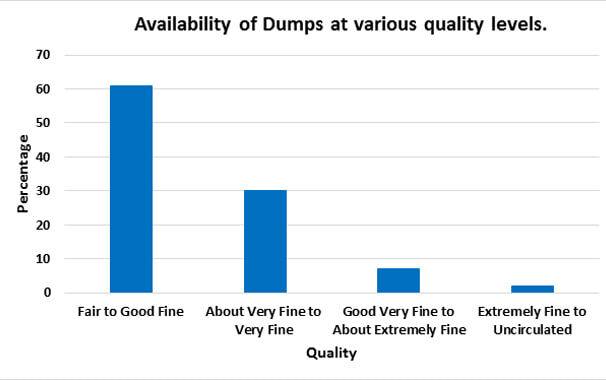
The 1852 Adelaide Pound
The discovery of gold in the 1850s is one of the most extraordinary chapters in Australian history, transforming the economy. And transforming our society for it marked the beginnings of a modern multi-cultural Australia instigated by mass migration, particularly from China.
Several coins were spawned by the Gold Rush, including our first gold coin, the 1852 Adelaide Pound. It was struck at the Government Assay Office in Adelaide without the sanction of the British Government or the approval of Queen Victoria.
To validate their actions in circumventing Royal protocols, the South Australian Legislators found a loophole in the Government’s regulations and passed the Bullion Act, that allowed them to create their own mint and strike gold ingots. And eventually strike gold coins.
The Bullion Act No 1 of 1852 has a record unique in Australian history. A special session of Parliament was convened to consider it. Parliament met at noon on the 28 January 1852. The Bill was read and promptly passed three readings and was then forwarded to the Lieutenant Governor and immediately received his assent. It was one of the quickest pieces of legislation on record, with the whole proceedings taking less than two hours.
Thirteen days after the passing of the Act, on 10 February 1852, the Government Assay office was opened. Its activities were supported by a state government initiative to provide armed escorts to bring back the gold from the Victorian diggings.
The Assay Office was effectively Australia's first mint, be it unofficial. Its sole purpose was to assay gold nuggets brought from the Victorian goldfields and to re-shape them into ingots. No minting expertise was required in the casting of the ingots.
Nine months later, following agitation from Adelaide’s business community, legislation was passed that authorised the Government Assay Office to strike gold coins. Within a week of opening, 600 gold Adelaide Pounds had been delivered to the South Australian Banking Company, 100 of which were sent to London.
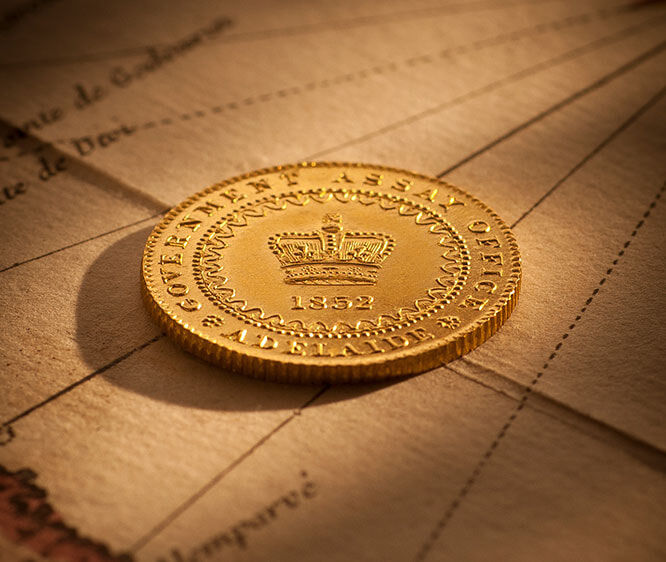
Photo shown above. The miracle of numismatics, the finest known Adelaide Pound Type II. Perfection in gold.
Suddenly precision was required. The design was intricate, created by colonial die sinker and engraver, Joshua Payne. So, it was always going to be a tough ask for a factory to start churning out currency to a defined weight and design.
The Bullion Act had a lifetime of only twelve months.
By the time the legislative amendments were passed to enact the production of gold coins, the Act had less than three months to run. As a consequence, only a small number of Adelaide Pounds were struck and very few actually circulated.
When it was discovered that the intrinsic value of the gold contained in each piece exceeded its nominal value, the vast majority were promptly exported to London and melted down.
The 1852 Adelaide Pound was as unofficial as you could get but it saved the colony of South Australia from bankruptcy. A simple case where the end justified the means.
Useful information if you are buying an Adelaide Pound
Collectors have options when it comes to acquiring a Holey Dollar, they being the mint and monarch of the original Spanish Dollar. And options with respect to the Dump of the A/1, D/2, C/4 or E/3 design type.
But, collectors also have options when it comes to the 1852 Adelaide Pound. Indeed, collectors have two options:
- The extremely rare and coveted Adelaide Pound Type I that came from the first production run of Adelaide Pounds.
- Or the very scarce Adelaide Pound Type II that was produced in the second production run.
Question. So how do we identify coins from the first and second production run? Answer. The coins have different reverse designs.
Coins from the first production run have a beaded inner circle surrounding the value of one pound. Coins from the second production run have a crenelated inner circle.
The obverse depicting the crown and the legend Government Assay Office Adelaide is however common to both.
But there is another very obvious difference between the two types of Adelaide Pounds. The Type I clearly evidences the disaster that occurred in the very first production run of the Adelaide Pound. That the reverse die had cracked, in the DWT section of the legend, the reason why it is also known as the Cracked Die Adelaide Pound.
Our first chart shown above, shows the drastic difference in availability of the Type I Adelaide Pound and the Type II.
There are perhaps 40 of the Type I and 250 of the Type II available to collectors. The difference creates an enormous price disparity.
An average Type I Adelaide Pound is $125,000-plus with very limited availability. A Type I would become available every few years.
An average Type II Adelaide Pound is $30,000 and several examples would be available annually.
Historians have established that disaster did indeed strike during the early stages of the minting of the Adelaide Pound. The reverse die cracked due to the pressure applied to the edges.
There was an upside to this disaster for the coins out of the first run have almost perfect edges, beautiful strong denticles, akin to a picture frame. As with any decision, there is often a downside for the pressure applied to the edges created shortcomings in the execution of the crown, the central part of the design.
The crown in most Type I Adelaide Pounds is slightly flattened and although some might suggest that this is simply due to wear, this is not the case. There was insufficient pressure on the central part of the dies to create the perfect crown.
There is another upside to the cracking disaster. Because the coin was considered 'imperfect' very few examples were put aside as souvenirs, making high quality Type I Adelaide Pounds extremely scarce.
Relaxing the pressure in the production of the second run of Adelaide Pounds lengthened the die usage, but created its own shortcomings. For once the pressure was reduced, the perfection that was achieved in the edges of the Cracked Die was simply not achievable.
Most Type II Adelaide Pounds will have some weakness in their edges in the Government Assay Office area. But nearly always, the crown design is perfectly executed with flattened areas simply due to wear. The challenge for collectors is to find an Adelaide Pound Type II that shows maximum strength in the edges. And they definitely exist!
If you follow our rule of thumb, we don’t think you will go far wrong in selecting a nice Adelaide Pound Type II. Start with the edges and work your way in. Confirm the strength of the edge denticles and the legend Government Assay Office. And then move inwards to the crown. Lastly examine the fields.
1855 Sydney Mint Sovereign and Half Sovereign
The Gold Rush of 1851 spawned the striking of the nation’s first official gold coinage, a sovereign and a half sovereign struck in 1855.
Unlike South Australia, which overcame a currency shortage by striking the Adelaide Pound, New South Wales followed protocol and petitioned for a branch of the Royal Mint London to be established in Sydney.
On the 19 August 1853 Queen Victoria gave approval to establish Australia’s very first mint at or near Sydney in New South Wales.
It was decided that, as the coin would only be legal tender in the colonies, a design specifically attributed to the Sydney Mint should be produced.
Designs of Australia’s first gold coinage were prepared in 1853 at the Royal Mint London. The Royal Mint also manufactured the dies.
The reverse design incorporated the words Australia and Sydney Mint, the inclusion of the word Australia, a point of fascination with historians. At the time the nation was operating as separate colonies. Australia did not operate under a single Government until Federation in 1901.
The Sydney Mint was established in a wing of the "Rum Hospital" in Macquarie Street, Sydney. The mint began receiving gold on 14 May 1855 and issued its first gold sovereign soon after on June 23. Months later, the Sydney Mint issued half sovereigns.
In their infancy the Sydney Mint sovereigns and half sovereigns were legal tender only in the colony of New South Wales. In 1857, the legal scope was widened to include all Australian colonies and Mauritius, Ceylon and Hong Kong. In 1868 the Sydney Mint Sovereigns and Half Sovereigns became legal tender throughout the British Empire.
The design of Australia's first sovereigns and half sovereigns - referred to as the Sydney Mint design - lasted until 1870 and was the only time the word Australia appeared on our gold sovereigns.
From 1871, Australia's sovereigns and half sovereigns took on a traditional British design.
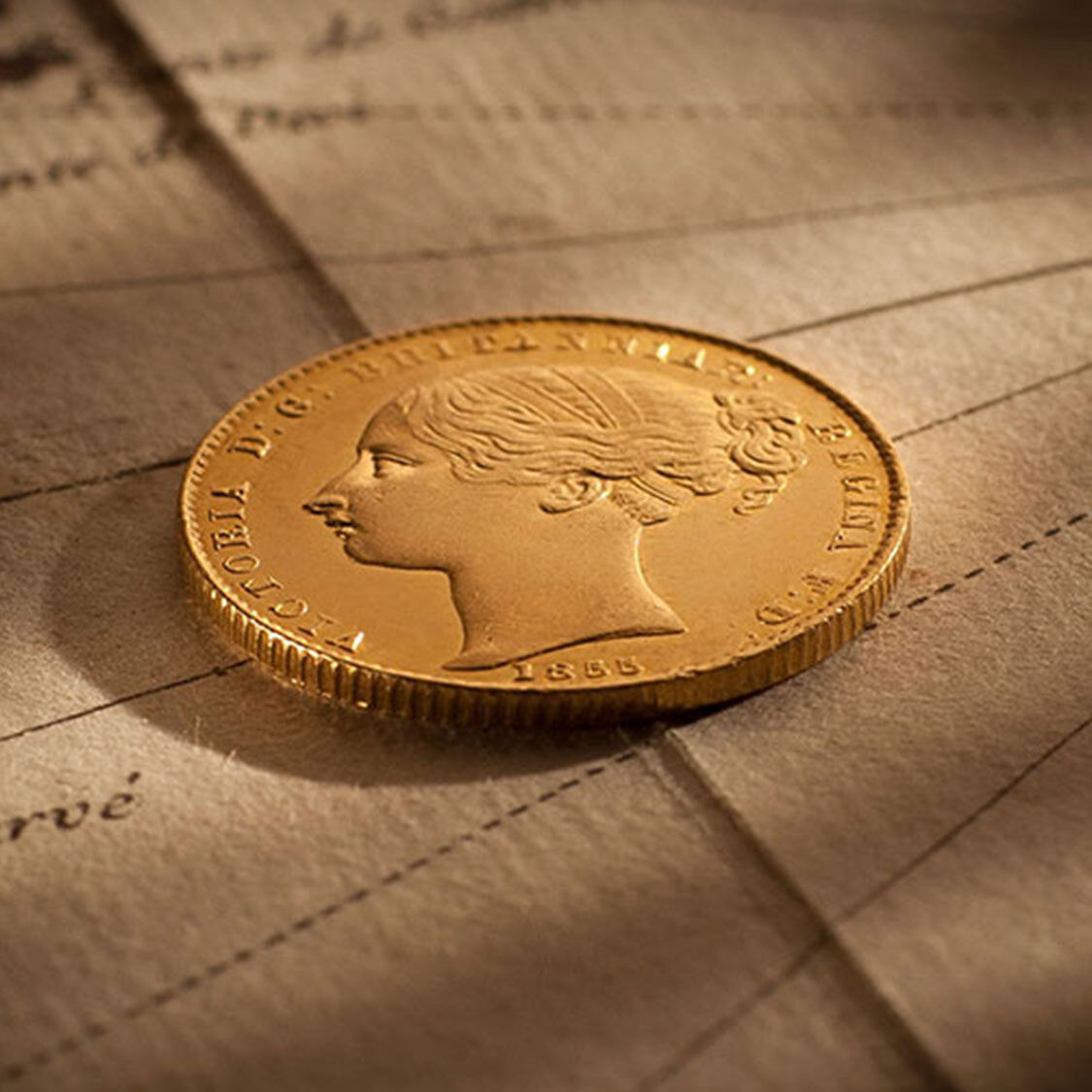
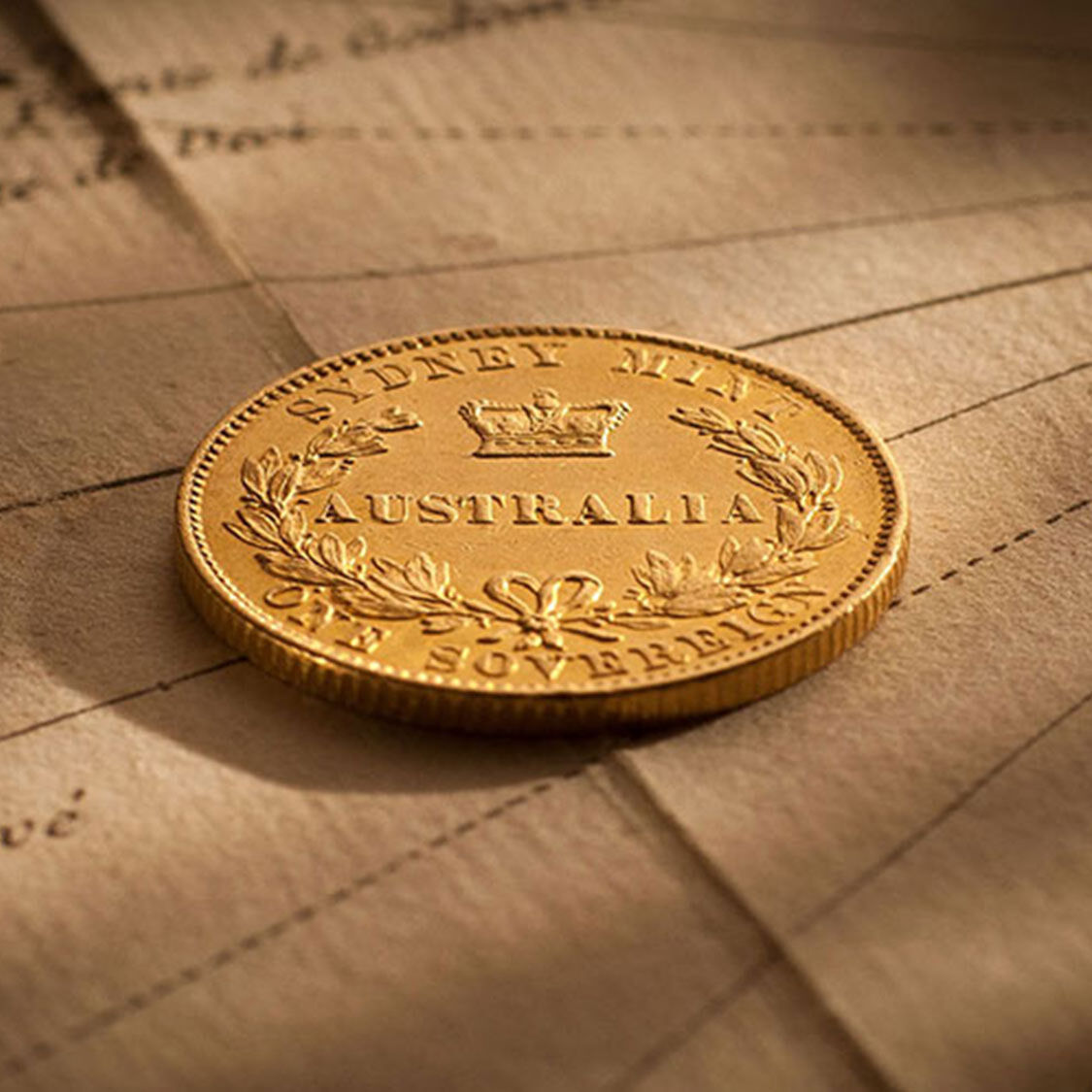
Photos shown above. Obverse and reverse of Choice Uncirculated 1855 Sydney Mint Sovereign.
Useful information if you are buying an 1855 Sydney Mint Sovereign
Every circulated coin has a grading level at which serious rarity kicks in. That is the point at which the balance between acquiring a coin as a collectible - and as an investment - shifts more towards the latter.
For the 1855 Sydney Mint Sovereign the level at which extreme rarity cuts in is ‘About Extremely Fine’.
At Very Good, the 1855 sovereign is virtually denuded of design. At Fine, the design is recognisable but most of the significant design elements have been worn away. At Good Very Fine, there are signs of wear and the high points are flattened. In a quality range of Very Good to Very Fine and even up to Good Very Fine, the 1855 Sydney Mint Sovereign is reasonably readily available. Refer the blue section of the pie chart.
A buyer could realistically expect to see several well circulated examples offered annually with prices ranging from $2000 to $10,000.
It’s at the quality level of About Extremely fine, through to Uncirculated and Brilliant Uncirculated that the going really gets tough for sovereign collectors and that prices escalate.
Our respect for the 1855 Sydney Mint Sovereign is well documented. It is the nation’s first official gold coin and in the upper quality levels is extremely rare. A rarity that far outweighs demand.
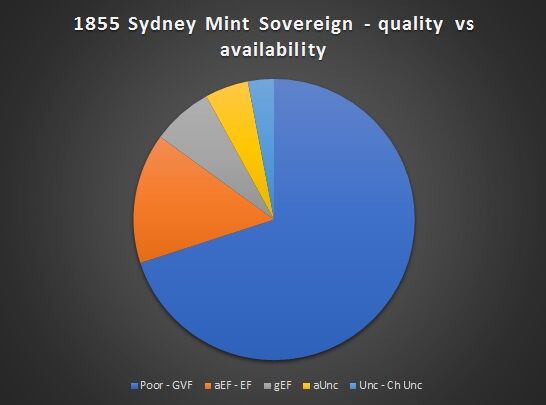
The ’55 sovereign is sought by the collector that is targeting key dates. The very first year of our official gold currency is an important date in Australia’s numismatic and financial history.
The 1855 sovereign also appeals to the sovereign collector.
And given the scarcity of the '55 sovereign in the upper quality levels, it also appeals to the investor.
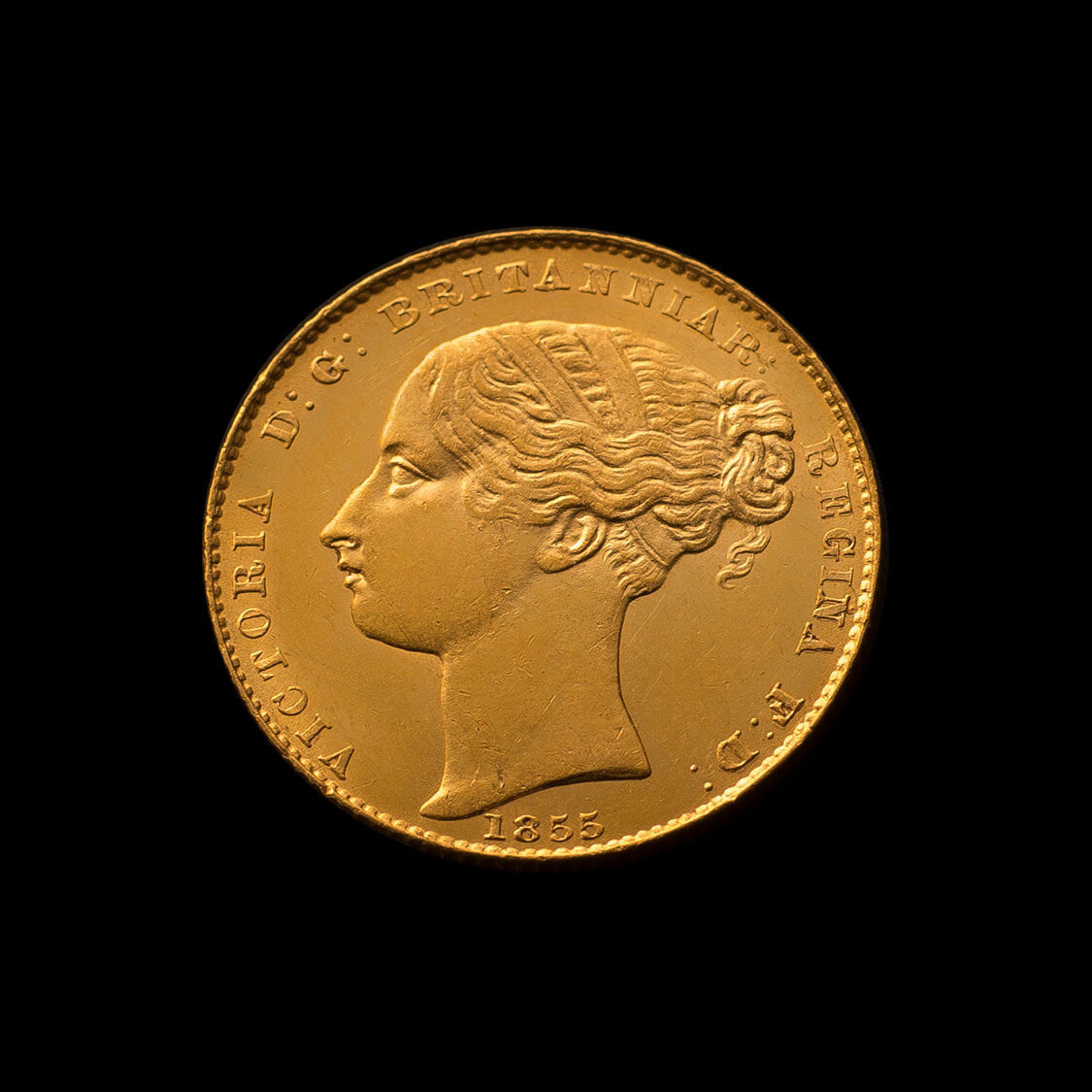
There is no wear to the high points of the design. Note the continuity in the hair lines on the forehead: a tell-tale high point.

No wear to the high points of the design and
virtually no bag marks marks in the fields.
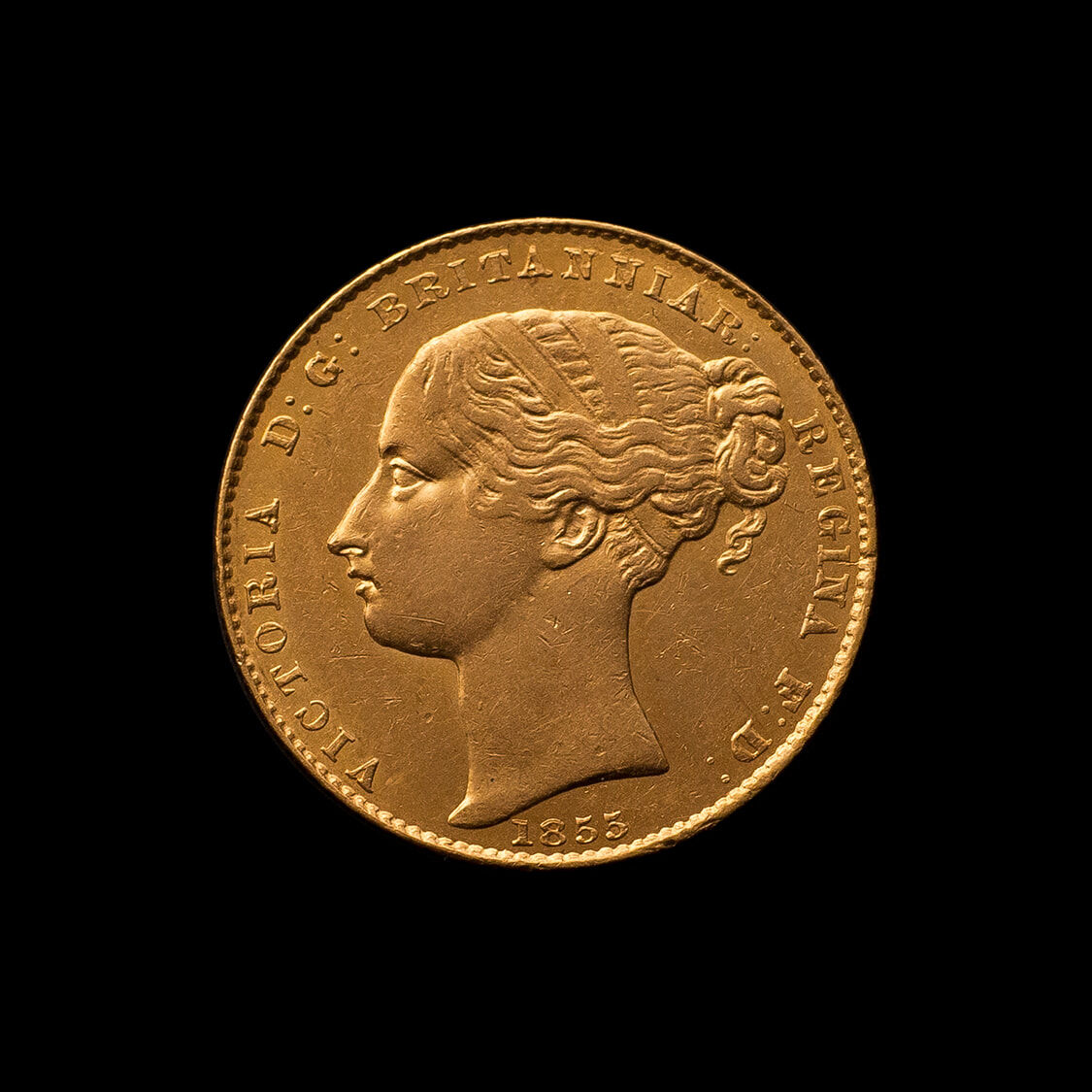
A hint of wear to the high points of the design evidenced in the hair lines on the forehead.
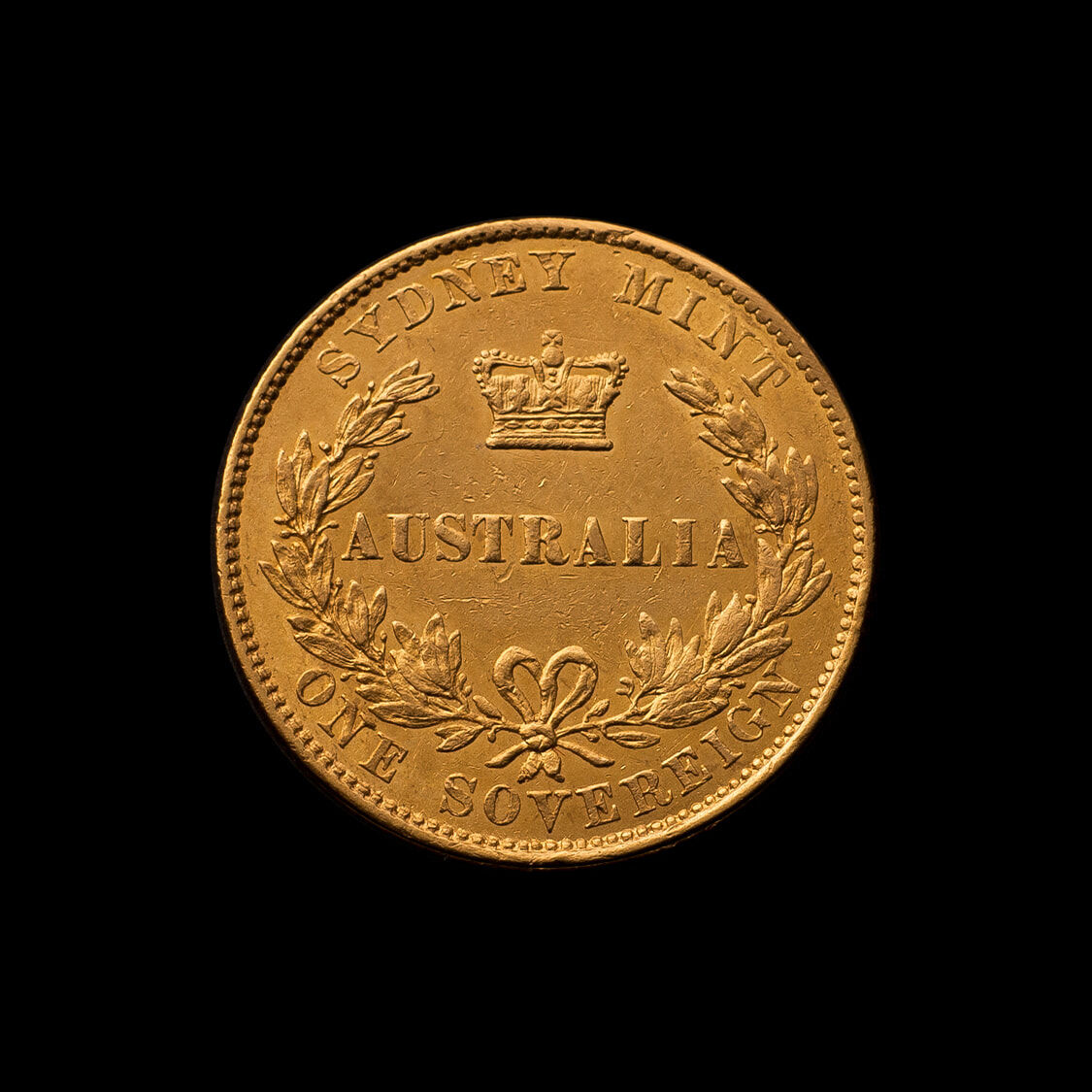
A hint of wear to the high points of the design.
Slight evidence of usage in the fields.

Note the wear to the hair on the forehead
and to the left of the ear.

Evidence of usage in the fields and
slight wear to the high points.
Useful information if you are buying an 1855 Sydney Mint Half Sovereign
As a company that specialises in high quality Australian rarities, the 1855 Sydney Mint Half Sovereign has always presented us with a massive dilemma. Simply because we value a coin's eye appeal very highly. And most 1855 Half Sovereigns come well worn.
We acknowledge that the 1855 Sydney Mint Half Sovereign is significant. It is the nation's first half sovereign struck at the nation's first mint, the Sydney Mint. The mintage was a sparse 21,000 making it Australia's rarest circulating coin. (Compare that to the mintage of the 1855 Sovereign of 501,000.)
We also acknowledge its extreme rarity. Perhaps forty examples are available to collectors. And its a coin that has international appeal.
It is the quality of the 1855 Half Sovereign that we find confronting. The majority of examples are found today well worn and virtually denuded of detail. Many are damaged with scratches, spade or metal detector marks. We note that a number have been holed.
It is obvious if you have a look at the descriptions that most 1855 Sydney Mint Half Sovereigns are (sadly) defined by their defects.
And yet each and everyone of them is rare. And each of them is highly valued. Even examples denuded of detail would probably command somewhere in the range of $6000 to $10,000.
The scarcity and the extensive use, of the 1855 Half Sovereign was evidenced at the Reserve Bank of Australia (R.B.A.) Auction in 2005 when the bank liquidated its holding of gold coins that had been accumulated between 1929 and 1976. Over a 47-year time frame, the R.B.A. had only accumulated seven 1855 Sydney Mint Half Sovereigns, all of which were well circulated, many of them damaged. Only one out of the seven showed any design detail graded at about Fine, with the remaining coins even further down the scale, virtually denuded of any significant design.
The highest quality 1855 Sydney Mint Half Sovereign is graded 'About Uncirculated'.
The first recorded owner of this coin was London collector, A. H. F Baldwin reflecting the international appeal of the 1855 Half Sovereign. It was later sold to Canadian Bill Barrett. A further exchange of hands saw the coin come back to Australia via Barrie Winsor to Queensland collector Tom Hadley of Quartermaster fame.
The coin was acquired by Coinworks in 2018 and sold to a Melbourne collector for $325,000.
The second finest known 1855 Half Sovereign is graded Extremely Fine. Acquired from Barrie Winsor, the coin was sold by Coinworks, again in 2018.
Alongside the Quartermaster example, the most famous 1855 Sydney Mint Half Sovereign is that formerly owned by veteran collector Roy Brook. The coin has a quality level of Good Very Fine.
The Brook Half Sovereign was first offered in Australia in 1976 and sold for $10,000. Twelve years later during Spink Auctions famous Bicentennial Auction (July 1988) it was re-offered and sold for $17,300. Its final appearance at auction was in 1995 when it sold for $45,100. Coinworks acquired the coin privately in 2003 and sold it for $97,500.
A high quality 1855 Sydney Mint Half Sovereign is, in our view, the ultimate prize.
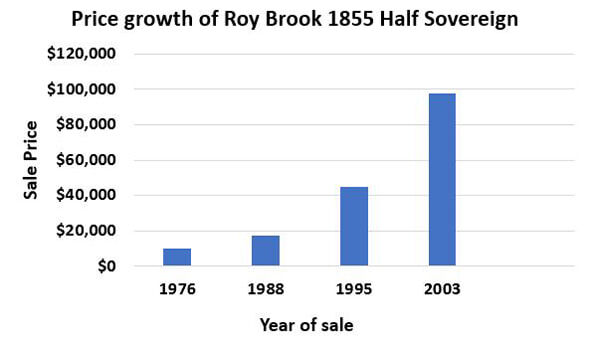
The 1919 Kookaburra Square Penny
The introduction of the Kookaburra Square Penny underpinned an attempt by the then Labor Government to stir up national sentiment post World War I. To evoke the great 'Aussie' spirit.
If you think about it. Putting the nation’s native bird - the kookaburra - onto a coin was a no-brainer to achieving that goal. A drastically changed shape, a square. And a new metal, cupronickel was part of the total package to maximise impact on the nation's citizens.
The proposal was contentious in that the monarch, King George V, was to be depicted on the obverse without a crown. Some say it was the rumblings of a Republican movement way ahead of its time.
Tests commenced at the Melbourne Mint in 1919 with the test pieces ultimately passed to dignitaries and Government officials to assess their reaction.
Four different coin designs were tested in 1919 and they are referred to as the Type 3, Type 4, Type 5 and Type 6.
The Type 3 Square Penny, with its modern lettering and sleek-style kookaburra, has a design that is unique. The Type 5 Square Penny also has a unique kookaburra design. The Type 4 and Type 6 share the same kookaburra design, but have different obverse designs.
All of the 1919 Square Pennies are extremely rare. The Type 4 would become available to collectors, once in a decade and is by far the rarest of those dated 1919. The Type 5 and Type 6 Square Pennies would be seen on the market perhaps once every five years. The Type 3 with its unique design would be seen on the market perhaps once every two years. The popularity of the Type 3 becomes immediately obvious when you look at these numbers. A collector still has to wait two years for a Type 3 Square Penny ... but that's better than waiting for ten!

Photo shown above. The 1919 Type 6 Square Penny, a superb FDC, almost proof-like.
Sadly, in 1921 and after three years of testing, the scheme fell apart. The response to Australia’s square coinage was poor with widespread public resistance to change and people generally rejecting the small size of the coins.
However, the final decision not to proceed seems to have been based mainly on another consideration – the large number of vending machines then in operation requiring a circular coin.
The Square Pennies that remain today are relics of our past, and the sentiment that they stir up in the current market is collector sentiment, driven by their novel shape and their extreme rarity.
Useful information if you are buying a 1919 Square Penny
Glancing at the photo of the 1919 Type 6 Square Penny shown above, you could be forgiven for believing that the Square Pennies were struck to exacting minting standards. Dare we suggest proof quality minting standards.
But the coin shown above is an aberration and one of the finest, its supreme quality traits reflected in its strike, its surfaces and the edges.
The Square Pennies were test pieces. Trials, so they were not struck to exacting minting standards, a tell-tale sign the lack of uniformity in the width of the edges.
Given to dignitaries to assess their reaction, there was no packaging and we know that not every dignitary was a collector and would have handled them with care.
Some of the coins must have been tucked into a fob pocket for they have circulated. Others could have rattled around a top desk drawer. Or passed around to colleagues ... introducing multi possibilities of mishandling. So preservation is a key issue with Square Pennies.
It is noted that the Kookaburra Square Pennies tone, some more strongly than others, a reflection on their storage in the intervening years.
A Square Penny with minimal/attractive toning and beautiful surfaces is a joy to behold. And a prized classic Australian coin rarity.
The 1930 Penny
The 1930 Penny is a part of Australian folklore. The coin is a national icon and its star status has made it one of Australia’s most valuable coins.
What’s most interesting is that the 1930 Penny stumbled into fame for a review of records at the Melbourne Mint confirms that apart from the six 1930 Pennies struck to proof quality, no pennies were struck for circulation in that year.
Many theories have been put forward as to the accidental minting of the 1930 Penny. One theory suggests that a few circulating strikes may have been minted at the same time as the Proof version, set aside and inadvertently issued years later by mistake.
The more popular explanation is also the more romantic. Mint policy dictated that the dies were prepared in readiness for the striking of a penny in 1930. The Depression and the lack of economic growth meant that, apart from striking a small number of halfpennies and gold sovereigns, the Melbourne Mint became a tourist attraction. It is thought that a mint guide minted small batches of 1930 pennies for tourists as souvenirs of their visit.
The suspected mintage is about 1500 coins.
The accidental minting of the 1930 Penny was not discovered until the 1940s, dealers responding to the discovery by offering to pay up to 10/- for an example. However, it wasn’t until the 1960s that the 1930 Penny became a national symbol. Newspapers were instrumental in creating that image, television played a lesser role.
Lists of Australian coins and their market prices and headlines such as “Have you cashed in on Australia’s coin craze yet?” and “A Penny could be worth £500” appeared in the 60s in the daily newspapers. The nation’s rare coin market reacted in a frenzy as thousands cashed in on the opportunity to make big money.
In 1964, the Sydney Sunday Telegraph published a guide to the latest prices on Australian coins. It was the first time that such a list had been published and, while most pennies were fetching a small premium over face value, the 1930 Penny was listed at £50 in Fine condition (today that same coin would be worth more than $20,000).
By 1965, a Fine 1930 Penny had more than doubled in price to £120. By decimal changeover, the price had moved to £255 ($510) and the 1930 Penny had captured the imagination of collectors and non-collectors alike.
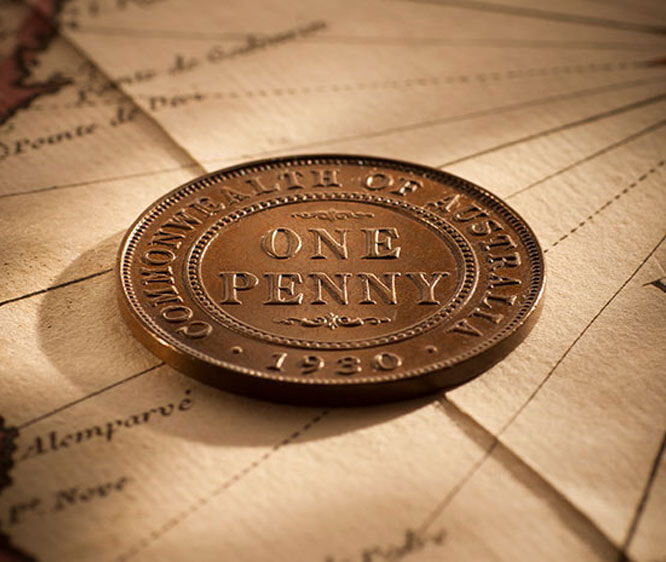
Photo shown above. One of the top four 1930 Pennies, presented in Good Extremely Fine.
Before the arrival of decimal currency in 1966, no Australian could look at a penny without glancing at the date, just in case it was the elusive ‘1930’. A product of the Depression, it was everyone’s chance to make big money fast.
The craze was fueled on the one hand by the lure of quick money and on the other by the pressure of the collector market for supplies. Decimal currency changeover posed an imminent and very real danger to coin collectors - the melting down of undiscovered rare pieces. Collectors keen to complete sets of all coins minted in Australia rushed to acquire the elusive pieces at rapidly escalating prices.
We are well into the decimal era now, so no one checks for pennies in schoolyards anymore. But maybe the backs of couches.
For many Australians however, the journey to acquire the 1930 Penny still goes on. It is to this day, Australia's favourite currency collectible.
Useful information if you are buying a 1930 Penny
For a lot of Australians, acquiring a 1930 Penny fulfills a lifetime’s ambition, a desire that began in childhood.
The first step in the task of acquiring a 1930 Penny is to set your budget.
1930 Pennies are available in price ranges to suit all budgets, starting at $20,000 for a well circulated example. A 1930 Penny, that to the naked eye, has its design details relatively intact, will be graded Very Fine and will command prices in excess of $45,000.
A coin that has undergone minimal circulation, graded Good Very Fine or better, is an aberration (perhaps ten are known) and will command prices upwards of $65,000 up to the very best example, graded at About Uncirculated and valued at $450,000-plus.
The best advice we can give potential 1930 Penny buyers is that irrespective of the quality level and the price, acquire a 1930 Penny that is visually very attractive and that has no obvious defects from its time in circulation.
The 1930 Penny was not discovered until the 1940s, allowing at least a decade of circulation before collectors even knew of their existence.
Which means that most of the 1930 Pennies had been handled, mishandled, dropped, scratched or rattled around in change.
Don’t accept the huge unsightly gouge. Or the massive edge knock. There will always be some signs of circulation with a 1930 Penny, but if they overwhelm the overall aesthetics of the coin, then in our view, don’t buy it.
Storage, how well a coin has been preserved, is also a contributing factor to the value of a 1930 Penny. If there are tell-tale signs of poor storage, the coin should be knocked back.
The very reason why we reject more 1930 Pennies than we accept. Our attitude with 1930 Pennies is clear. There are a number of 1930 Pennies around, but not all of them are worth having.
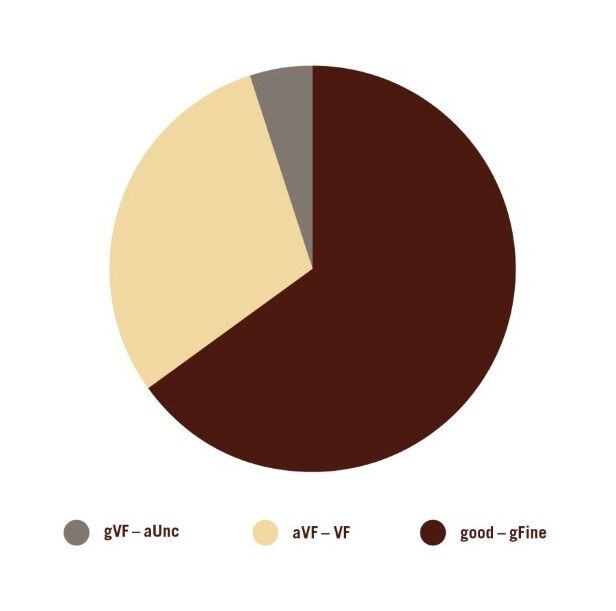
The pie chart shown above shows the scarcity of a 1930 Penny at the various quality levels.
Explanation for tabs:
gVF - aUnc
Exceptional quality Good Very Fine to About Uncirculated.
aVF - VF
High quality About Very Fine to Very Fine.
good - gF
A well circulated Good to Good Fine and the quality level at which 1930 Pennies are frequently sighted and offered.
© Copyright: Coinworks